How Many Sapsuckers?
Author: Norm Budnitz
When I moved into my newly constructed house in 1986, there was only one tree anywhere close to the house site. I had chosen the site for several strategic reasons. It was near the edge of a field, which meant no trees to cut down or stumps to pull out. It meant a beautiful view to the west across about four acres of pasture, complete with occasional gorgeous sunsets. It also meant that my passive solar design could soak up lots of warming sunlight all day long in the winter and store it in my brick floors, to be released gently all night long. I only had to supplement with wood heat when there was overcast, rain, or snow for more than a day or two in a row. This made for cozy, comfortable nights without having to burn any fossil fuels.
But there were downsides as well. In summer, that same sun beat down on the house, and especially in the afternoon, it blasted my west-facing windows. HOT! And I like trees. I really, really like trees. So I immediately made the important compromise of planting deciduous trees in my yard. I knew that as they grew up, they would provide shade in summer, and when they dropped their leaves in fall, they would let in those warming afternoon rays. Now, 30 years later, there are redbuds, pawpaws, fringe trees, and sugar maples providing flowers in the spring, fruits and seeds in the fall, and nice cover for the birds visiting the feeders on my deck. And yet the sunsets are still gorgeous in the winter.
A few years after I moved in, I noticed that I was being visited each winter by a Yellow-bellied Sapsucker or two. These northern breeders are not in our area in summer, but migrate each fall to spend their winters here.
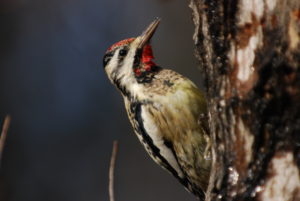 Yellow-bellied Sapsucker
Yellow-bellied SapsuckerWell, these specialized woodpeckers were not visiting me exactly, but rather were working their magic on my sugar maples. They would come by each morning and dig rows of shallow holes in the trunks and larger branches.
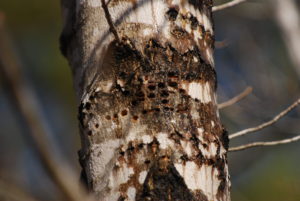 Sapsucker holes in a sugar maple
Sapsucker holes in a sugar mapleThen they would come back periodically throughout the day and drink the exuding sap and eat any insects that were attracted to or trapped by that sap. Nice adaptation, don’t you think?
It wasn’t long after I first saw the sapsuckers that I noticed that other birds were taking advantage of the sapsucker wells. I began taking photographs of as many other ‘sap suckers’ as I could. Here’s a sampling. It’s wonderful how nothing goes to waste in nature.
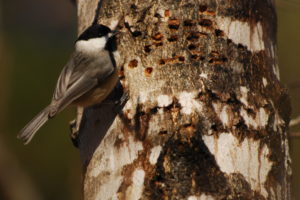 Carolina Chickadee sapsucker
Carolina Chickadee sapsucker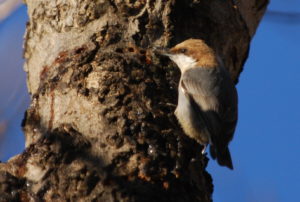 Brown-headed Nuthatch sapsucker
Brown-headed Nuthatch sapsucker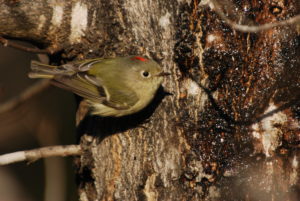 Ruby-crowned Kinglet sapsucker
Ruby-crowned Kinglet sapsucker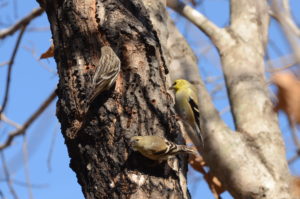 Siskin and Goldfinch sapsuckers
Siskin and Goldfinch sapsuckersAs of this writing, my total list of ‘sap suckers’ is:
• Yellow-bellied Sapsucker (of course)
• Downy Woodpecker
• Carolina Chickadee
• Tufted Titmouse
• White-breasted Nuthatch
• Brown-headed Nuthatch
• Ruby-crowned Kinglet
• Yellow-rumped Warbler
• Pine Warbler
• White-throated Sparrow
• Dark-eyed Junco
• House Finch
• American Goldfinch
• Pine Siskin
• Oh, and Gray Squirrel!
Here’s a link to a photo gallery of all these sap-sucking freeloaders:
https://goo.gl/photos/cT41DAANwGHzuCm97